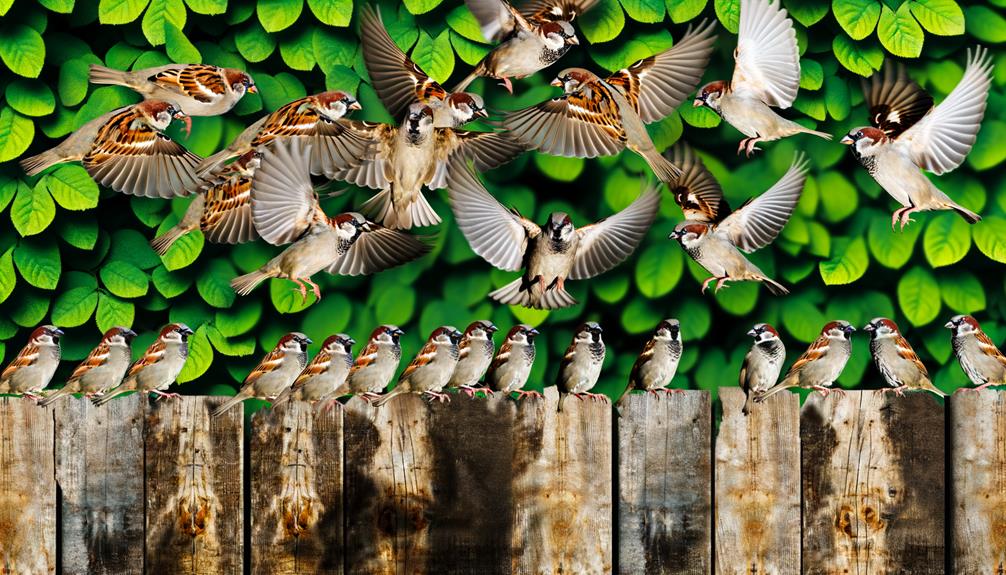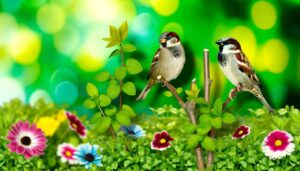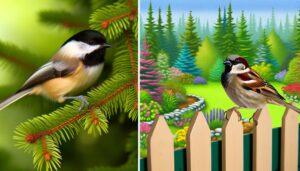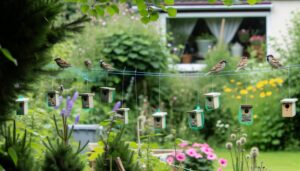3 Surprising Facts About House Sparrows
The House Sparrow (Passer domesticus) originated in the Middle East around 10,000 years ago, closely aligned with Neolithic farming communities. This highly adaptable avian species measures 16 centimeters in length and weighs between 24 to 39 grams, with males usually larger.
Its diet consists mainly of seeds, grains, and insects. Known for its distinctive sexual dimorphism in plumage, males feature black bibs, while females and juveniles display earthy tones.
House Sparrows exhibit complex social structures, including flocking and cooperative behaviors. Despite thriving in urban environments, populations have primarily declined due to habitat loss and pollution.
Explore the myriad adaptations and challenges in detail.

Key Takeaways
- House Sparrows originated in the Middle East around 10,000 years ago.
- They have adapted well to human environments, including urban areas.
- Males have distinctive black bibs and white cheeks, while females are more subdued in color.
- Their diet includes seeds, grains, insects, and human food scraps.
- House Sparrow populations have declined by 60% in Europe since the 1980s due to habitat loss and other factors.
Origins and History
The House Sparrow (Passer domesticus) originated in the Middle East approximately 10,000 years ago, coinciding with the advent of agriculture and human settlement. This species exhibited synanthropic behavior, adapting to human-altered environments.
Archaeological evidence suggests a close association between early Neolithic farming communities and sparrow populations. Genetic studies indicate that the House Sparrow's spread correlates with human migration patterns, particularly through Europe and Asia.
These birds capitalized on grain stores and human refuse, enhancing their survival and proliferation. By the 19th century, the House Sparrow had been intentionally introduced to North America, Australia, and other regions due to its perceived benefits in pest control.
Today, Passer domesticus thrives globally, reflecting its extraordinary adaptability and resilience.
Physical Characteristics
House sparrows (Passer domesticus) exhibit a compact body structure, with an average length of 16 centimeters and a mass ranging from 24 to 40 grams.
Their plumage is characterized by a combination of gray and brown hues, with males typically displaying more pronounced black bibs and white cheeks.
Notable distinctive features include a stout bill adapted for seed consumption and sexually dimorphic color patterns, aiding in easy identification.
Size and Weight
Adult house sparrows (Passer domesticus) typically measure approximately 16 centimeters in length and weigh between 24 to 39 grams, with males generally being slightly larger than females. This size and weight range places the house sparrow within the small passerine category.
Morphometric analyses reveal that males average around 1 to 2 grams heavier than females, a dimorphism that can be attributed to their slightly larger skeletal structure. Weight can vary seasonally, influenced by factors such as food availability and breeding cycles.
Wing length, often used as a correlating metric for overall body size, averages around 7.5 centimeters. Such measurements are essential for ornithological studies, providing insights into species' health, behavior, and ecological adaptability.
Color Patterns
Beyond their size and weight, Passer domesticus exhibits distinct color patterns, with males typically showcasing a combination of gray crowns, reddish-brown napes, and black bibs, while females and juveniles are characterized by more subdued, earthy tones and streaked backs. Detailed observations highlight the following:
| Attribute | Male Characteristics | Female/Juvenile Characteristics |
|---|---|---|
| Crown | Gray | Brownish |
| Nape | Reddish-brown | Brown |
| Bib | Black | Absent |
| Back | Brown with black streaks | Brown with lighter streaks |
| Underparts | Pale gray | Grayish-brown |
These color patterns serve as essential identifiers for differentiating between sexes and age classes, providing ecological and behavioral insights.
Distinctive Features
Distinctive features of *Passer domesticus* include a sturdy bill adapted for seed-eating, coupled with wing bars that are more prominent in males than in females.
The males exhibit a striking black bib, extending from the throat to the upper chest, which serves as a secondary sexual characteristic. Females and juveniles display more muted coloration, with a mainly beige plumage and less pronounced wing bars.
The average body length of an adult House Sparrow ranges from 14 to 16 centimeters, with a wingspan of approximately 21 to 25 centimeters. The tail is relatively short and rounded. Sexual dimorphism is evident, with males possessing more vibrant and contrasting plumage.
These characteristics facilitate identification and play vital roles in mating and survival strategies.
Diet and Feeding Habits
The diet of the house sparrow (Passer domesticus) is mostly composed of grains and seeds, but it also includes insects and food scraps from urban areas. Observational studies indicate that house sparrows display opportunistic feeding behavior, often frequenting human-populated regions where food availability is high.
Data collected from various habitats show significant variation in food sources, influenced by geographic and seasonal factors.
Common Food Sources
House sparrows mainly consume a diet consisting of seeds, grains, and insects, with a marked preference for agricultural crops such as wheat, barley, and oats. Their diet is opportunistic, allowing them to thrive in diverse environments. Importantly, they also consume weed seeds and waste grain, contributing to their adaptability. During the breeding season, the intake of insects, including caterpillars and aphids, increases to meet the protein requirements for nestlings. Data indicates that approximately 75% of their diet consists of plant material, while the remaining 25% comprises animal matter.
| Food Type | Percentage of Diet |
|---|---|
| Seeds and Grains | 75% |
| Insects | 25% |
| Agricultural Crops | Mainly wheat, barley, and oats |
This dietary flexibility underscores the house sparrow's ecological success.
Feeding Behavior Patterns
Observational data reveals that the feeding behavior patterns of Passer domesticus exhibit temporal and spatial variations, influenced by factors such as food availability, environmental conditions, and reproductive cycles.
During breeding seasons, increased insect consumption is noted, providing essential protein for nestlings. Conversely, non-breeding periods see a shift towards granivory, primarily consuming seeds and grains.
Spatially, urban populations display opportunistic feeding, exploiting anthropogenic food sources, whereas rural counterparts rely on natural foraging.
Morning and late afternoon peaks in feeding activity are documented, correlating with diurnal temperature fluctuations and predator avoidance strategies.
These patterns underscore the adaptability of Passer domesticus, ensuring survival across diverse habitats and fluctuating resource landscapes. Consistent observations affirm these findings, highlighting the species' ecological plasticity.
Breeding and Nesting
Breeding and nesting behaviors of house sparrows (Passer domesticus) reflect their adaptability and resilience. They often commence in early spring when environmental conditions are favorable.
Males establish territories by vocalizing and displaying at potential nesting sites. Nest construction is a collaborative effort, utilizing grass, feathers, and an array of urban materials.
Clutch sizes range from 3 to 7 eggs, with incubation lasting approximately 11-14 days, primarily by the female. Post-hatching, both parents participate in feeding the altricial chicks.
Fledging occurs around 14-17 days post-hatch, but juveniles remain dependent on parental care for several weeks. House sparrows may produce multiple broods per breeding season, a strategy that enhances their reproductive success and population stability.
Social Behavior
Social interactions among house sparrows (Passer domesticus) are characterized by complex hierarchical structures and frequent vocal communications, facilitating cohesion within flocks and efficient resource allocation.
Dominance hierarchies, established through pecking orders, dictate access to food and nesting sites, with alpha males often securing prime resources. Vocalizations play a pivotal role in maintaining these hierarchies, with specific calls denoting alarm, mating readiness, or territory.
Studies indicate that flocks can consist of up to 20 individuals, with social bonds reinforced through allopreening and synchronized foraging behaviors. Observational data reveal that cooperative behaviors, such as mobbing predators, enhance survival rates.
These intricate social dynamics underscore the adaptive success of house sparrows in diverse environments.
Adaptations to Urban Life
House sparrows display remarkable adaptability to urban environments, leveraging their opportunistic feeding habits and flexible nesting strategies to thrive amidst human activity. These birds consume a varied diet ranging from grains to discarded human food, greatly enhancing their survival rates. Nesting in urban structures such as eaves, vents, and streetlights, they exploit human-made environments for shelter. Studies have shown a correlation between urban density and sparrow population growth, indicating strong urban affiliation.
| Factor | Adaptation Strategy | Benefit |
|---|---|---|
| Diet | Opportunistic feeding | Increased food availability |
| Nesting Locations | Use of human structures | Enhanced shelter options |
| Urban Density | Positive population correlation | Higher population resilience |
Such adaptability underscores their success in urban settings, ensuring their prevalence in densely populated areas.
Conservation Status
Despite their remarkable adaptability to urban environments, the conservation status of house sparrows has raised concerns in recent years due to significant population declines observed in various regions. Studies indicate a 60% reduction in European populations since the 1980s, with similar trends in North America. Contributing factors include habitat loss, pollution, and reduced food availability linked to changes in agricultural practices.
Additionally, increased predation by domestic cats and competition with other bird species exacerbate these declines. Conservation efforts prioritize habitat restoration, pollution control, and public awareness campaigns. Ongoing research aims to better understand the multifaceted causes of decline and develop effective strategies to stabilize and potentially recover house sparrow populations globally.
Conclusion
The house sparrow, with its intricate history and remarkable adaptability, exemplifies resilience akin to a tenacious vine in an urban jungle. Detailed observations reveal its physical traits, diverse diet, and complex social behaviors, underscoring its success in varied environments.
Despite facing conservation challenges, data-driven studies highlight the species' capacity to thrive amidst human-altered landscapes. The house sparrow's journey from rural origins to urban ubiquity underscores its significant ecological footprint and enduring presence across global habitats.






